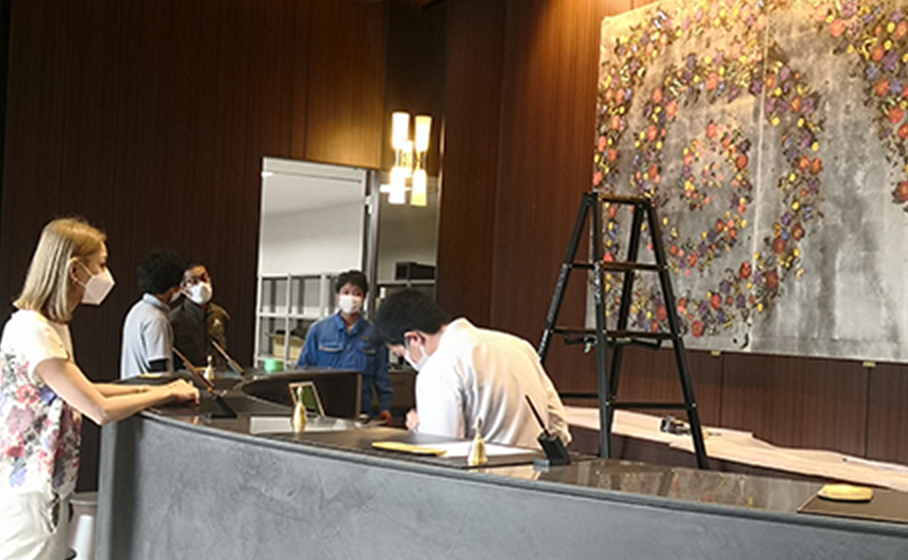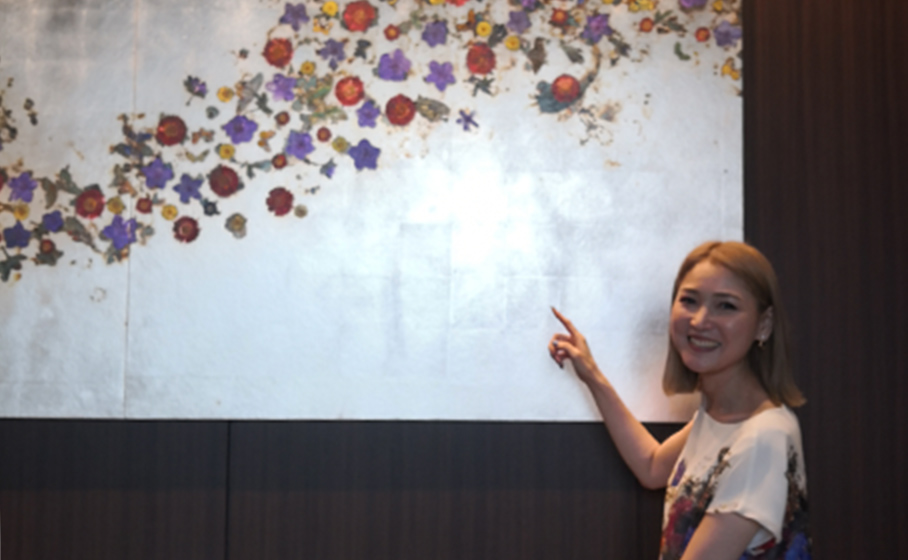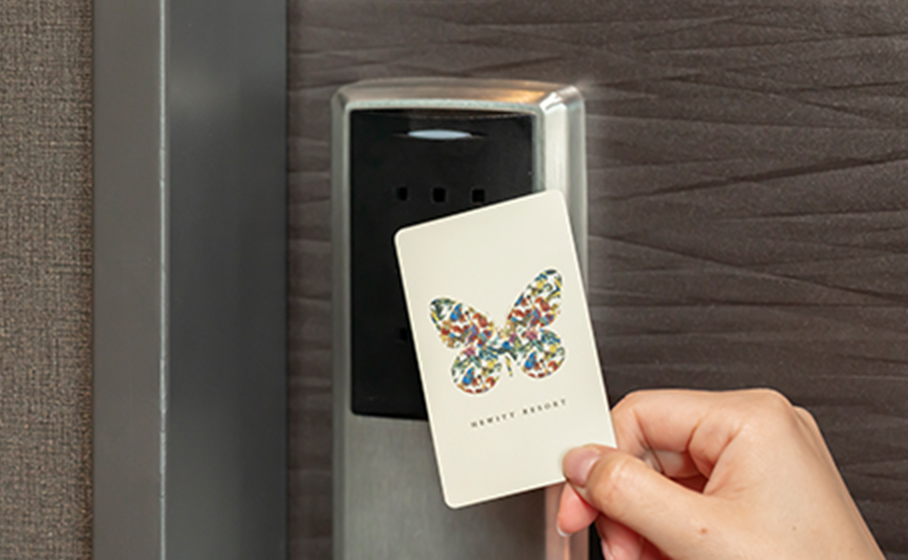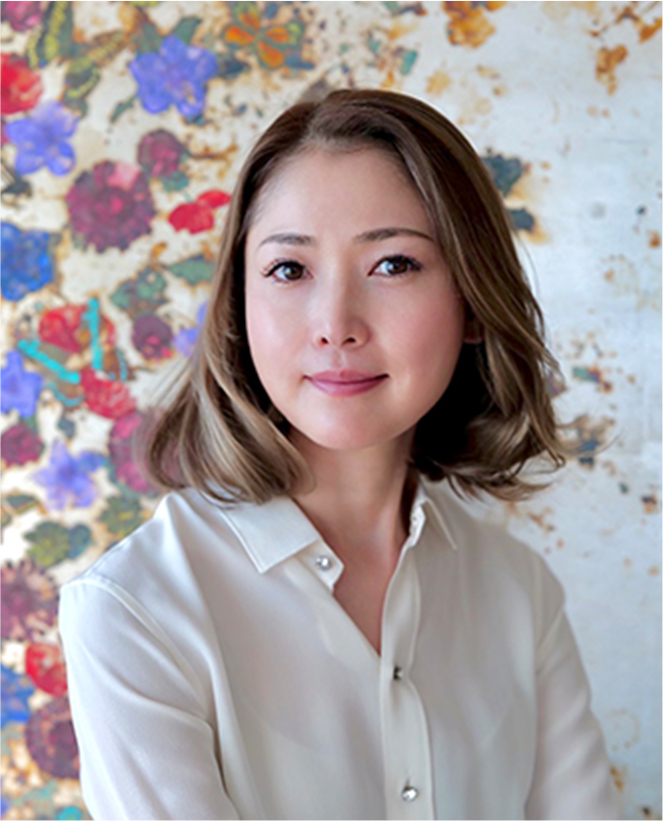Contemporary Japanese painter
Hiroko Otake's painting "Nature's Spiral"
is on display in the lobby of Hewitt Resort Naha.
Natureʼs SpiralArtwork Statement
The ever-changing and unstoppable "flow" attracts many people.The "spiral" or "whirlpool" of the work's title exists in various forms in nature. The forms of plants, flowers, leaves and buds have evolved to capture the sun's rays more efficiently.As the ultimate form of evolution, whirlpools and spirals seem to teach us the meaning of beauty. While basically a repeating structure, the shape of the spiral, which does not stay in the same position but ascends infinitely, can also be seen in the structure of DNA, reminding us of life force and growth.
The images that I overlay on the butterflies and flowers that I use as motifs are always in the present moment, in flux. Butterflies have a complete metamorphosis from larva to chrysalis, and from chrysalis to adult, becoming completely different butterflies, and fly in a flickering manner. I feel the transience, strength, and beauty of plants and the natural order in which flowers bloom from buds, eventually wither, and produce seeds.
Accepting the fluid and ephemeral as it is, finding it in nature, and attempting to achieve spiritual maturity while coexisting with the nature is a part of the Japanese identity.
My goal is to interpret and create works that show the symbiosis of different cultures, the symbiosis of parts and the whole, the symbiosis of history and the present, and the aesthetic sense of the symbiosis of nothing and something.

INTERVIEW INTERVIEW
A painting that graces the lobby. It is a large work, 4.2 meters wide, with colorful butterflies and flowers scattered across the screen.For the opening of the hotel, we asked Hiroko Otake, a contemporary Japanese painter, to create a painting for us. Ms. Otake is an up-and-coming artist who has been involved in a wide range of art activities, including solo exhibitions and exhibits in Japan and abroad, as well as corporate collaborations such as L'ATELIER do Joel Robuchon, Salvatore Ferragamo, and the promotion of the entire Shibuya Seibu department store. He is an up-and-coming artist with a wide range of artistic activities, including corporate collaborations such as the promotion of the entire Seibu department store in Shibuya. About a month before the opening of the hotel, we spoke with Otake, who had successfully completed the installation of his works, about his work and his creative activities.

01Sublimate the traditional into the modern
Japanese painting has a somewhat "austere" image, but Otake's paintings are very different from that austere image.The source of this difference was Ms. Otake's idea of pursuing her own sense of beauty without being caught up in stereotypes.There are various genres of painting, such as figurative painting, abstract painting, oil painting, watercolor painting, etc. Among them, Japanese-style painting refers to the use of Japanese paper and mineral pigments. Some people may have the image that Japanese-style painting is somehow "austere," but I am trying to sublimate the traditional into the modern, and let people know that there are things that are not so traditional. I am working on my works with the hope that people will see that there are things that are not so traditional.
02Enjoy the texture
In this work, I used Japanese paper, mineral pigments, and silver leaf, a technique unique to Japanese painting. Iwa-enogu is a naturally occurring paint made from ore, but it has a unique texture and the colors change dramatically when mixed. Also, the silver leaf that covers the entire canvas is used as a base for the flowers and butterflies by partially creating a chemical reaction that gives them a decayed look.

03"Nature's Spiral"
-Homeostasis in a moment of flux.
The concept of this exhibition is "Nature's Spiral". Countless flowers and butterflies create a large vortex. Ms. Otake believes that it is only through constant change that we can realize the important things that remain unchanged, and this "homeostasis in a fluid moment" is a consistent theme of her art activities. There are many spirals and whorls in nature, such as the overlapping of petals and the appearance of leaves and buds. These spirals and whorls have evolved over a long period of time to allow the sun's rays to penetrate more efficiently. The DNA in our bodies is also in the shape of a spiral, and I find the spiral/vortex form mysterious, and the structure of the spiral/vortex, which does not stay in the same position but rises infinitely, reminds me of life force and growth. Like spirals, butterflies and flowers are also two of my favorite motifs, and both spend their entire lives changing their shapes. Butterflies undergo a complete metamorphosis, from egg to larva, through chrysalis to adult. A flower is a seed that sprouts, blooms, and then withers to become a seed, leading to the next new generation. The spiral symbolizes the constant flux, and the flowers and butterflies symbolize the fluid present moment, which I hope will be an approach to the essence of constancy. The technique of sulfurizing silver foil is also related to flowers and butterflies in the sense that it changes the material.
04Find Me!
Among the many different types of butterflies depicted in this work is the Okinawa Prefecture butterfly, the "Giant Sesame Butterfly". One of the butterflies depicted in this exhibition is the Okinawa Prefecture's "Giant Sesame Butterfly," whose large wings are characterized by black radial streaks and spots on a white background. "Each of the three canvases is a single work, and there is one giant sesame butterfly on each canvas. I hope you will find one.

05Artist's Message
The hotel is a place to enjoy and refresh yourself away from everyday life. My work will be displayed at the entrance of the hotel, so I hope it will serve as a gateway to the unusual and stimulate your stay in Okinawa. I would also be happy if people would notice the vortex in my work. I hope visitors will find the fluidity and change symbolized by the whirlpool, flowers, and butterflies in the nature and climate of Okinawa, and feel more refreshed.
ARTIST
Graduated with a major in Japanese Painting (Nihonga) at the Department of Painting, Tokyo University of the Arts in 2006. Completed a Doctoral Program and earned PhD in Japanese Painting in an Art Education course at Tokyo University of the Arts Graduate School in 2011. Received the Emerald Grant Award from Tokyo University of the Arts in 2014. Has lived in New York during 2015-2016 as part of the Ministry of Culture's overseas exchange program for upcoming artist. In 2019, she donated her work "Psyche" to the Vatican City on the occasion of the Pope's visit to Japan. She is renowned in Japan and abroad for her novel expression using metal leafs and mineral rock pigments based on traditional Japanese painting techniques.
- 2006
-
Graduated from Japanese Painting (Nihonga) course at Tokyo University of the Arts
Graduation work, Teikyo University, Tokyo, Japan
- 2008
-
Completed a Master's course in Japanese Painting in an Art Education course at Tokyo University of the Arts Graduate School
- 2009
-
The 19th scholarship Award (Sato International Cultural Scholarship Foundation)
- 2011
-
Completed a Doctoral Program and earned PhD in Japanese Painting in an Art Education course at Tokyo University of the Arts Graduate School
- 2011-14
-
Research Assistant, Tokyo University of the Arts (TUA)
Japanese Painting, Department of Painting
- 2014
-
The Emerald Grant Award (Tokyo National University of the Arts)
- 2015-16
-
The Ministry of Culture's overseas exchange program for upcoming artist (New York, USA)
- 2019
-
Donation of the work "Psyche" to the Vatican City State on the occasion of the Pope's visit to Japan
Currently, she is widely engaged in art activities in Japan and abroad for her novel expression using metal leafs and mineral rock pigments based on traditional Japanese painting techniques.

